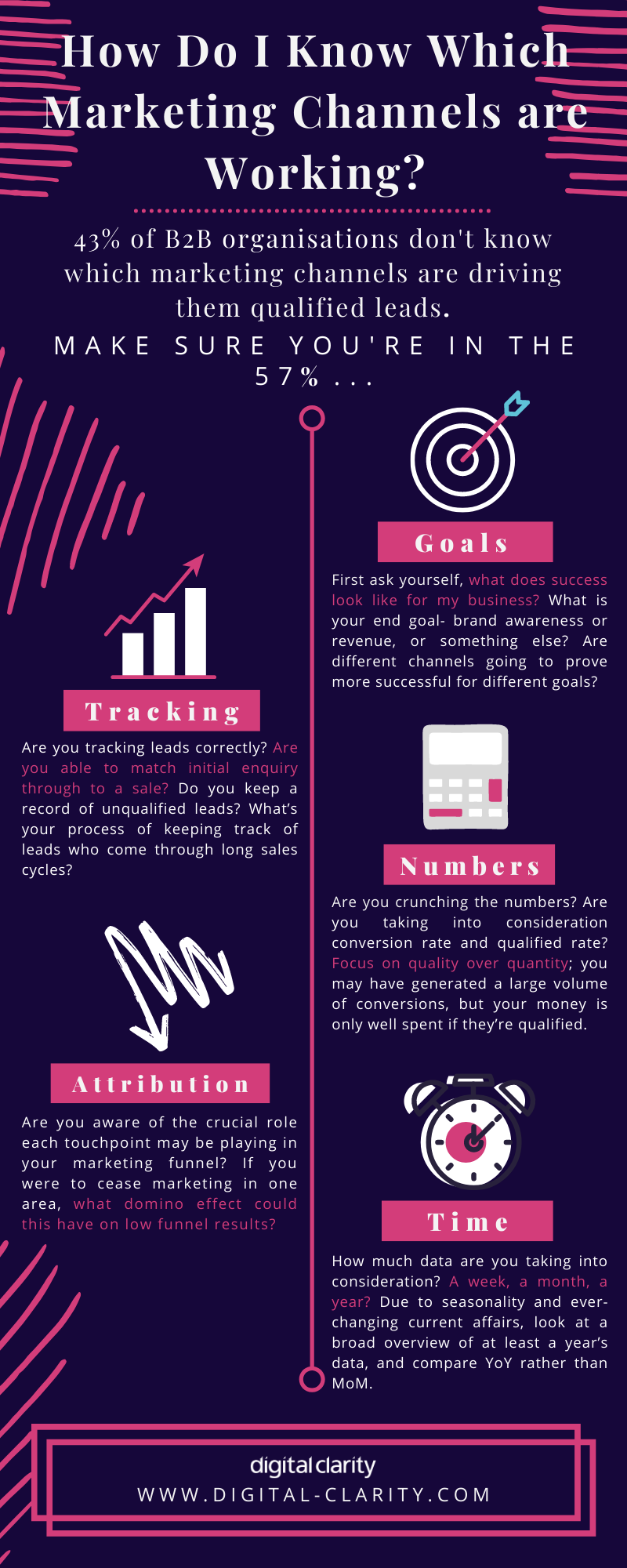During consultancy workshops with new clients in the B2B space, there is often a stumbling block when asked which marketing channels drive the most qualified leads. The majority will not have a clear answer or don’t know where to start to find out.
This led us to conduct an internal study which revealed that a staggering 43% of B2B organisations don’t know which marketing or sales channels are driving them qualified leads.
Why This Should Change
You might be wondering: why do I need to identify which marketing channels are the most successful for my business?
Well dear reader, if you don’t know what’s working, how can you make informed decisions about where to spend marketing budgets? More importantly, how can you maximise your ROI?
At the same time, how are you planning your budgets in the first place if you are not clear on what is and isn’t working?
70% of the businesses who aren’t aware of which channels were driving qualified leads also said that they don’t take into consideration past performance when allocating marketing budgets.
87% of these businesses allocate budgets without carrying out projections of future performance.
Although determining marketing success can be difficult for those with long sales cycles, we feel it’s a must in order to ensure you’re spending your budgets in the right places.
For example, if you only invest your budgets in channels that show immediate last touch results, you could be disregarding the influence other channels have had earlier on in the marketing funnel. This may lead to the starving of spend in some areas which are crucial players in the buyer’s journey as a whole.
So, let’s take a look at how you can tackle the difficulty of identifying which marketing channels are providing you with the best returns.
How to Identify Which Channels Are Driving Marketing Qualified Leads

Goals
First, establish what success looks like for you. What is your end goal?
Align your goals with KPIs. If your goal is brand awareness, you shouldn’t be measuring success by counting conversions.
Are different channels going to prove more successful for different goals?
How somebody finds out about your business will most likely be different from how they take action.
Tracking
Are you tracking your leads correctly? Are you able to match initial enquiry through to a sale?
KPIs such as impressions, reach, clicks, brand uplift, conversions and leads are only short term indicators of success. ROI indicates long-term value and growth.
For B2B businesses, tracking conversions and leads isn’t enough. You should be matching conversions to leads, and leads to sales and revenue. Learn more about how to turn B2B advertising into actual ROI.
Numbers
Think quality over quantity. On the surface, a campaign may look like it’s performed the best if it’s generated the highest number of conversions, but are those conversions qualified?
Look not at volume but instead at conversion rate and qualified rate. Your money is only well spent if your conversions are actually qualified.
Attribution
Are you taking into consideration the crucial role each touchpoint may be playing in your marketing funnel? If you were to cease marketing in one area, what domino effect could this have on low funnel results?
It’s often not as simple as one channel driving the majority of leads. Multi-channel marketing by definition puts emphasis on the role that each channel can play in the customer’s journey.
In an ideal world, we would all be able to see each touchpoint a customer interacted with before converting. But, CRM tools that allow you to see a transparent and accurate view of your customer’s journey often come with hefty price tags and privacy concerns.
For B2B organisations with long lead to sales cycles, and no set monetary value attached to conversions, it is more difficult to determine the specific return each marketing channel is generating.
Using tools such as Google Analytics Model Comparison Tool can help you compare the different roles marketing channels play in the user journey. For a refresh on marketing attribution, check out our complete guide to attribution modelling.
Time
How much data are you taking into consideration? Seasonality and changing current affairs can impact results, so ideally get a balanced view of the data by looking at a broad time period.
It is important to remember that if you have a long sales cycle your period of measuring success is going to have to match that.
77% of marketers attempt to measure ROI during the first month of a campaign.
Of those, 55% of marketers actually had a sales cycle that was three months or longer (LinkedIn). This means that ROI isn’t being accurately reported on.
Struggling to determine which marketing channels are working for your business?
Need help allocating marketing budgets for your upcoming year?
Book an initial assessment call with us.







